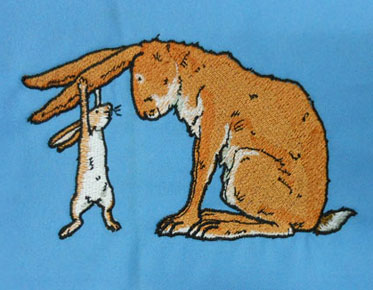Should I Digitize My Own Designs or Outsource Them?
Are you thinking about digitizing your embroidery designs? Do you need to learn how to digitize your designs? Are you trying to figure out if you should pay someone to update your embroidery software so that you can digitize your designs? Well, if you're thinking about those questions then please read my article.
In today's embroidery world, there's no point sitting in front of a computer and digitizing a design when you can get somebody to do it for you for a couple of bucks. You need to keep your embroidery machines running, and the best way to do that is to outsource your designs and spend your time digitizing them and running your machines.
Many designs can take hours to digitize, like the one on the right. This is a jacket back design with lots of details. The client wanted to see it in full color, then decided it was too much and just wanted an outline.
At the end of the month, you'll be able to accomplish more than digitize or set up all your own designs. Your bottom line is what matters most at the end of the month!
What to look for in a good digitizer!
First, what is a good digitizer? A good digitizer is someone who works with you and helps you look good to clients. A good digitizer will understand the embroidery process and know how to make your designs look their best on your particular type of fabric.
Make sure your digitizer is production aware so that there are as few trimming and color changes as possible. Make sure he or she sews the design before sending it to you. You need to see what the design looks like when it is sewn into the fabric. This is a big problem for many digitizers, especially for graphic artists. They got the software and thought that since they could create any type of graphic art, they could digitize their embroidery designs. This is not always true. Many times, they have no idea about the sewing process, know nothing about push-pull compensation, pad stitching or density, all of which are important factors in creating a high-quality design.
The best place to find a good digitizer is through a sales representative in your area who sells you embroidery design software. He or she should be able to direct you to the type of digitizer person you are looking for.
If you can find a digitizer to digitize your designs with the same type of embroidery software you're using, then it's the best of both worlds. This makes it easier for you if you need to change the size or change some fabric settings. With the right tools and education, you can do this yourself.
Introduce important information about your design to the digitizer
Design the type of fabric that will be sewn
The finished dimensions of the design.
How many color stops you want in your design and where. Many times, if your clothing changes color, you want to change a specific color.
If you will be using this design for any other type of application
In what format do you want your design done - preferably your software's native format, such as .EMB or .pixel. You will also need a .DST file. If you have the original file, you can handle any edits that might be required.
You will want to be able to increase or decrease the size of the design from the original size
Let them know there are some changes they can make to the design to make it sew better, like increasing the letter size or choosing a different font style?
Should I digitize my own embroidery designs? I would say that you better learn how to become an expert in editorial design. What you need is the ability to edit the design in case you want to make some changes. Having excellent editing skills is very important. If you don't have great editing skills, this is where you need to focus your learning.



